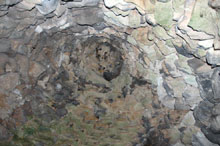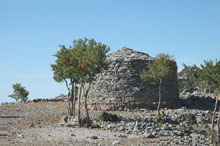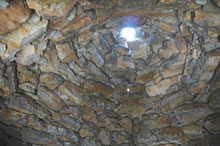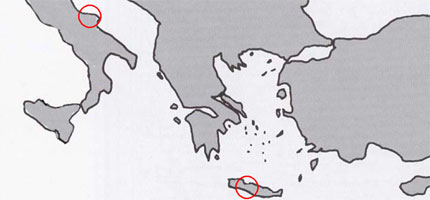The beginning of the inhabitation of Apulia (Puglia) and Southern
Italy has been lost to history even though there are several opinions
about it.
Herodotus gives his own view on the inhabitation of the area, prompted by
the description of the reactions and the attitude of the Greeks during the
Persian invasion in 480 B.C. The Cretans following the advice of Pythia did
not participate in the war. The facts Herodotus (and Pythia of Delphi) mentions,
had taken place 500 years before Herodotus wrote his
Histories.
[7.169] But the Cretans, when the Greeks, appointed to deal with them, were trying
to gain their aid, acted as I will show. They sent messengers to Delphi, inquiring
if it would be to their advantage to help the Greeks. The Pythia answered them,
“Foolish men, was not the grief enough which Minos sent upon your people for
the help given to Menelaus, out of anger that those others would not help to
avenge his death at Camicus, while you helped them to avenge the stealing of
that woman from Sparta by a barbarian?” When this was brought to the ears of
the Cretans, they would have nothing to do with aiding the Greeks.
[7.170] Now Minos, it is said, went to Sicania, which is now called Sicily, in
search for Daedalus, and perished there by a violent death. Presently all the
Cretans, except the men of Polichne and Praesus, were bidden by a god to go with
a great host to Sicania. Here they besieged the town of Camicus, where in my
day the men of Acragas dwelt, for five years. Presently, since they could neither
take it nor remain there, because of the famine which afflicted them, they departed.
However, when they were at sea off of Iapygia, a great storm caught and drove
them ashore. Because their ships had been wrecked and there was no way left of
returning to Crete, they founded there the town of Hyria, and made this their
dwelling place, accordingly changing from Cretans to Messapians of Iapygia, and
from islanders to dwellers on the mainland. From Hyria, they made settlements
in those other towns which a very long time afterwards the Tarentines attempted
to destroy, thereby suffering great disaster. The result
was is that no
one has ever heard of so great a slaughter of Greeks as that of the Tarentines
and Rhegians; three thousand townsmen of the latter, men who had been coerced
by Micythus son of Choerus to come and help the Tarentines, were killed, and
no count was kept of the Tarentine slain. Micythus was a servant of Anaxilaus
and had been left in charge of Rhegium; it was he who was banished from Rhegium
and settled in Tegea of Arcadia, and who set up those many statues at Olympia.
[7.171] In relating the matter of the Rhegians and Tarentines, however, I digress
from the main thread of my history. The Praesians say that when Crete was left
desolate, it was populated especially by Greeks, among other peoples. Then, in
the third generation after Minos, the events surrounding the Trojan War, in which
the Cretans bore themselves as bravely as any in the cause of Menelaus, took
place. After this, when they returned from Troy, they and their flocks and herds
were afflicted by famine and pestilence, until Crete was once more left desolate.
Then, came a third influx of Cretans, and it is they who, with those that were
left, now dwell there. It was this that the priestess bade them remember, and
so prevented them from aiding the Greeks as they were previously inclined. [Translation
by A. D. Godley.]
Whether the residents of Apulia have Cretan origin or not, is difficult to prove
– although it remains an enchanting version. Soon, however, the residents of
Apulia became autonomous, they were named Messapians and were divided in other
races (Iapyges, Peuketians, Leukanians etc.). When the Greeks reached the coasts
of Apulia, they faced the animosity of the Messapians who possessed the most
fertile territories of Southern Italy, the plain of Apulia. The efforts of the
Tarantians, despite their precarious successes, turned out fruitless and were
limited only around their city, taking advantage of the exit to the sea and their
safe port.
This was the situation until the Roman invasions (3
rd century B.C.);
the Messapians were friendlier to the Romans hoping for the defeat of their opponents,
the Tarantians. However, until the 2
nd century all cities, Greek and
Messapic, were gradually subjugated to the invincible Romans.
The Cretan mitata and the sheepfolds of the farmers
of Gargano
In central Crete, in the mountain of Psiloritis, numerous shepherds
have been
living for centuries in their mitata, their stone huts, which are built
according to the Minoan system in the shape of a dome. Similar buildings are
found in the Gargano peninsula, at the rocky ends of Monte Sant’ Angelo at a
height of 800-1000m., which have been used by the farmers of the area.
 |
 |
| The houses of the farmers in Gargano
at the Monte Sant’ Angelo area are built according to the Minoan
system. |
| |
 |
 |
| The mitata of the farmers in Psiloritis,
in Crete, are found in the planes of the mountain at a height
of 1000-1500 m. |
| |
 |
| The area of Psiloritis in Crete and the peninsula
of Gargano in Italy. |
| |
|